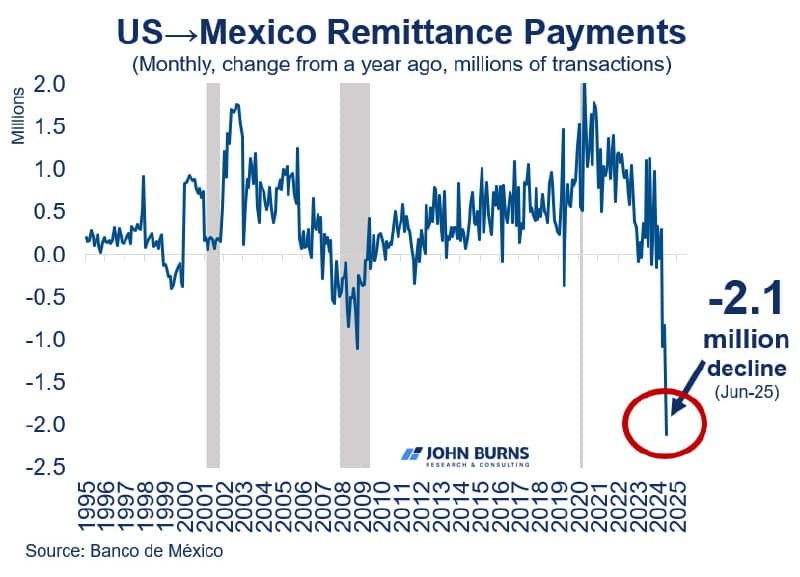US Immigrants Exit Workforce in Record Numbers, Sparking $2B Decline in Remittances
In a striking shift, the United States is witnessing a mass exodus of immigrants from its workforce, contributing to a notable decline in remittance payments to Mexico. Recent data reveals that remittances sent from the U.S. to Mexico have plummeted by over $2 billion compared to the previous year, marking the largest drop in over three decades. This trend unfolds against a backdrop of economic uncertainty and social challenges that are reshaping the immigrant landscape in the country.
Background & Context
The departure of immigrants from the U.S. workforce comes amid a myriad of economic pressures and changing immigration policies. Historically, immigrants have played a crucial role in bolstering the American economy, filling essential roles in various sectors, from agriculture to technology. However, recent years have seen a tightening of immigration laws and heightened scrutiny of immigrant workers, leading to an environment that some describe as increasingly inhospitable.
According to experts, this decline in remittance payments is unprecedented, especially considering that it follows significant economic downturns, including a homebuilding depression and a severe financial crisis that spanned a century. The current situation represents a significant shift in historical trends, where remittances have typically increased as immigrants sought to support families back home.
Key Developments
The data indicating a drop of more than $2 billion in remittances sent to Mexico is alarming for both economies. The decline is attributed to several factors, including increased costs of living in the U.S. and a challenging job market that has led many immigrants to reconsider their positions or return to their home countries. The ramifications of this trend extend beyond individual families, impacting local economies in both the U.S. and Mexico that rely heavily on these financial transfers.
Experts suggest that the current labor market dynamics, characterized by rising wages and a competitive job environment, might be prompting some immigrants to seek opportunities outside the U.S. Additionally, recent developments in immigration policy may be contributing to a sense of instability among immigrant communities, prompting them to reevaluate their futures in America.
Broader Impact
The implications of this mass departure are profound. Economists warn that as remittance flows decrease, families in Mexico who depend on these funds for basic necessities may face increased hardship. This situation could lead to a ripple effect, impacting education, healthcare, and overall economic conditions in regions that traditionally benefit from these financial inflows.
Furthermore, the decline in immigrant workers could exacerbate labor shortages in key sectors of the U.S. economy. As previously reported, industries such as agriculture and hospitality are already struggling to fill positions, and the loss of immigrant labor could hinder economic recovery in the aftermath of the COVID-19 pandemic. The current trend mirrors similar situations seen during economic downturns when immigrant populations often bear the brunt of labor market fluctuations.
What"s Next
Looking ahead, the trajectory of immigration policy in the U.S. will likely play a pivotal role in shaping the future of the workforce. Ongoing debates in Congress about immigration reform could either alleviate or further complicate the challenges facing immigrant communities. As lawmakers grapple with these issues, the specter of a declining workforce looms large over economic recovery efforts.
Additionally, community organizations and advocacy groups are mobilizing to address the immediate needs of families affected by this decline in remittances. Initiatives aimed at providing support for those struggling with financial insecurity are expected to gain momentum in the coming months, as both governments and non-profits seek to mitigate the impacts of this historic shift.
As the situation continues to evolve, stakeholders on both sides of the border will be closely monitoring the implications of these changes, with particular attention to how they affect economic stability and community resilience in the face of adversity.

![[Video] Trump administration reexamines Afghan imports under Biden for security risks](/_next/image?url=%2Fapi%2Fimage%2Fthumbnails%2Fthumbnail-1764617457888-ocscze-thumbnail.jpg&w=3840&q=75)
![[Video] Refugee admissions to the U.S. are nearly at 0, except for Afrikaners](/_next/image?url=%2Fapi%2Fimage%2Fthumbnails%2Fthumbnail-1764617445438-tw0del-thumbnail.jpg&w=3840&q=75)
![[Video] Trump suggests U.S. asylum process will be paused for a long time](/_next/image?url=%2Fapi%2Fimage%2Fthumbnails%2Fthumbnail-1764541860292-f1xogn-thumbnail.jpg&w=3840&q=75)



![[Video] Vladimir Putin delivers speech in military uniform](/_next/image?url=%2Fapi%2Fimage%2Fthumbnails%2Fthumbnail-1764621642413-vh08a-thumbnail.jpg&w=3840&q=75)
